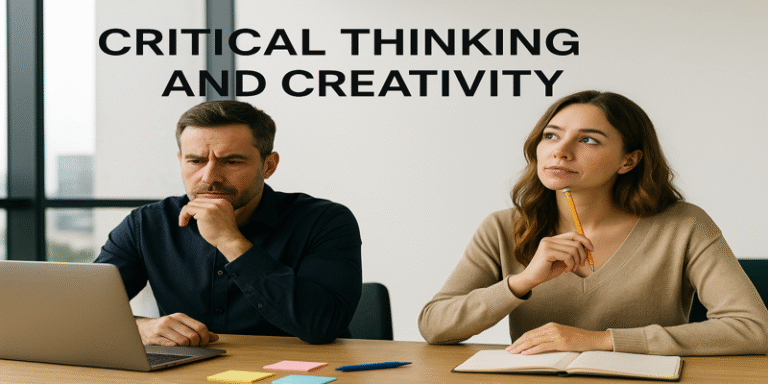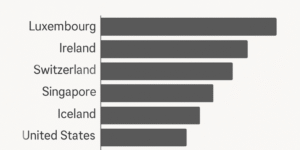In a rapidly evolving global environment characterised by complex challenges, critical thinking and creativity are increasingly recognised as essential competencies for success in academic, professional, and personal contexts. These cognitive processes enable individuals to solve problems, make decisions, and generate innovation in diverse settings (Facione, 2011). While the two concepts are distinct in focus and application, they are deeply interconnected and complementary. Critical thinking is primarily concerned with the evaluation of information and arguments, whereas creativity focuses on the generation of original and valuable ideas. Both, however, are indispensable for effective reasoning, innovation, and lifelong learning in the twenty-first century (Runco & Jaeger, 2012; Paul & Elder, 2001).
1.0 Understanding Critical Thinking
Critical thinking can be defined as the intentional, reflective process of analysing information, assessing arguments, and forming reasoned judgments based on logic and evidence (Paul & Elder, 2001). It involves skills such as interpretation, analysis, inference, evaluation, explanation, and self-regulation (Facione, 2011). Through these abilities, critical thinkers challenge assumptions, recognise biases, and make well-founded decisions.
According to Brookfield (2012), critical thinking is a process of questioning beliefs and actions to make informed choices. It requires individuals to move beyond surface-level understanding and examine the underlying rationale and evidence behind claims. In professional contexts, for instance, managers who employ critical thinking can evaluate strategic options more effectively, balancing risks with opportunities to enhance organisational performance.
Furthermore, critical thinking is systematic—it depends on reasoning guided by intellectual standards such as clarity, accuracy, relevance, and fairness (Elder & Paul, 2020). It allows individuals to distinguish between fact and opinion and to make sound decisions even in the face of uncertainty. In an age dominated by digital information and misinformation, this skill is crucial for navigating complex data environments (Peterson, 2025).
2.0 Defining Creativity
In contrast, creativity is often described as the capacity to produce ideas or products that are both novel and useful (Runco & Jaeger, 2012). Creativity involves imagination, intuition, and divergent thinking—the ability to explore multiple possible solutions rather than converging on a single correct answer. It encourages experimentation, openness to new experiences, and flexibility of thought (Puccio, Mance & Murdock, 2018).
Guilford’s (1950) pioneering work on creativity introduced the concept of divergent thinking as a key component of creative thought. Divergent thinkers generate multiple perspectives and connections between seemingly unrelated ideas. Similarly, Amabile (1996) proposed that creativity is influenced by three interacting components: domain-relevant skills, creativity-relevant processes, and intrinsic motivation. These dimensions help individuals transform knowledge and imagination into innovative outputs.
For example, in the technology sector, creativity drives product innovation and differentiation. Companies such as Apple and Tesla exemplify how creative design thinking enables the translation of abstract ideas into practical solutions that transform industries (Huang, Zhong & Tang, 2025). In education, fostering creativity helps students approach problems through inquiry and curiosity, rather than rote learning (Siregar, 2025).
3.0 Differences between Critical Thinking and Creativity
Although both skills contribute to cognitive excellence, their primary orientations differ. Critical thinking is evaluative, structured, and rule-governed, focusing on determining truth and reliability. It demands convergent reasoning, in which diverse information is synthesised into a logical conclusion (Paul & Elder, 2001). Conversely, creativity is exploratory, generative, and open-ended, emphasising originality and novelty rather than correctness (Runco & Jaeger, 2012).
According to Anderson, Potočnik and Zhou (2014), critical thinking involves convergent processes that narrow possibilities to select the best answer, while creativity relies on divergent thinking to expand the range of potential ideas. Critical thinking answers the question “Is this valid?”, whereas creativity asks “What if?” (Brookfield, 2012). The former values rational analysis, and the latter values imaginative synthesis.
This distinction is evident in decision-making contexts. A critical thinker evaluating a business proposal will focus on data, logic, and feasibility, ensuring that the decision is well justified. A creative thinker, on the other hand, will consider innovative approaches that might redefine the proposal’s objectives or identify untapped opportunities. The best leaders, therefore, are those who can integrate both—evaluating the viability of novel ideas through critical scrutiny (Facione, 2011).
4.0 Similarities between Critical Thinking and Creativity
Despite their differences, critical thinking and creativity share significant common ground. Both are higher-order thinking processes that require reflection, flexibility, and metacognition—awareness of one’s thought processes (Sternberg, 2003). They rely on curiosity, open-mindedness, and the willingness to question conventional wisdom.
Mumford et al. (2017) argue that both critical and creative thinking involve complex problem-solving, though they differ in emphasis: critical thinking evaluates, while creativity invents. Similarly, Vygotskian theories highlight that both processes are socially and contextually influenced—collaboration often stimulates critical dialogue and creative ideation (Petreshak, 2025). In practice, creative solutions often emerge from critical analysis, while critical assessment refines creative output.
Bloom’s taxonomy also illustrates their interdependence: critical thinking aligns with evaluation and analysis, while creativity corresponds to synthesis and creation—the highest cognitive levels (Anderson & Krathwohl, 2001). Thus, rather than existing in opposition, they function as complementary aspects of effective reasoning.
5.0 The Interdependence of Critical and Creative Thinking
In today’s knowledge economy, the integration of critical and creative thinking is vital for innovation and adaptability. Puccio, Mance and Murdock (2018) suggest that creativity provides the raw ideas that critical thinking filters and refines into practical solutions. Conversely, critical analysis can inspire creativity by exposing gaps, contradictions, and possibilities for improvement.
Design thinking, widely used in business and education, exemplifies this synergy. It involves empathising, defining, ideating, prototyping, and testing—a process that requires both critical assessment and creative ideation (Pachumwon, Jantakoon & Laoha, 2025). For instance, when developing new software, teams engage in creative brainstorming to generate innovative features, followed by critical evaluation to determine feasibility and user impact.
In education, research shows that students who are trained in both critical and creative thinking exhibit greater problem-solving skills, innovation, and academic achievement (Viani & Firmansyah, 2025). Integrating both abilities into curricula helps students become adaptable thinkers capable of responding to complex real-world challenges.
6.0 Implications in Professional and Educational Contexts
In professional environments, the combination of critical and creative thinking enhances strategic decision-making and innovation. Leaders use critical thinking to evaluate market trends and risks, while creativity enables them to envision new business models and products (Brookfield, 2012). For example, during the COVID-19 pandemic, organisations that adapted through creative problem-solving—such as remote work models—thrived, while those relying solely on traditional analysis struggled (Peterson, 2025).
In education, fostering both skills prepares students for an unpredictable future. The Organisation for Economic Co-operation and Development (OECD, 2018) identifies critical thinking and creativity as core competencies for lifelong learning. Pedagogical approaches such as project-based learning, problem-based learning, and inquiry-based teaching encourage students to combine logical reasoning with creative exploration (Viyanti, Shofi & Wiyanti, 2025).
In conclusion, critical thinking and creativity are distinct yet mutually reinforcing processes that form the foundation of effective problem-solving, innovation, and learning. Critical thinking provides the discipline of reason and evidence-based judgment, ensuring accuracy and coherence, while creativity injects originality, imagination, and adaptability into thinking. As Facione (2011) and Mumford et al. (2017) affirm, their integration leads to greater strategic adaptability and intellectual versatility.
In a world increasingly shaped by complexity and change, success depends not merely on thinking critically or creatively in isolation, but on the synergistic application of both. The ability to analyse deeply and imagine boldly equips individuals and organisations to navigate uncertainty and shape a more innovative and reflective future.
References
Amabile, T.M. (1996) Creativity in Context. Westview Press.
Anderson, L.W. & Krathwohl, D.R. (2001) A Taxonomy for Learning, Teaching, and Assessing: A Revision of Bloom’s Taxonomy of Educational Objectives. Longman.
Anderson, N., Potočnik, K. & Zhou, J. (2014) Innovation and creativity in organizations: A state-of-the-science review. Journal of Management, 40(5), pp.1297–1333.
Brookfield, S. (2012) Teaching for Critical Thinking: Tools and Techniques to Help Students Question Their Assumptions. Jossey-Bass.
Elder, L. & Paul, R. (2020) The Miniature Guide to Critical Thinking Concepts and Tools. Foundation for Critical Thinking.
Facione, P.A. (2011) Critical Thinking: What It Is and Why It Counts. Insight Assessment.
Huang, H., Zhong, X. & Tang, X. (2025) Teachers’ Emotional Support Matters for Adolescents’ Creative Self-efficacy and Performance. Thinking Skills and Creativity, 48, 101178.
Mumford, M.D. et al. (2017) Cognitive skills and leadership performance: The nine critical skills. The Leadership Quarterly, 28(1), pp.24–39.
Pachumwon, T., Jantakoon, T. & Laoha, R. (2025) A Design Thinking-Driven Conceptual Framework for a Creative AI Learning Environment to Enhance Programming Skills (CAILE). ResearchGate.
Paul, R. & Elder, L. (2001) Critical Thinking: Concepts and Tools. Foundation for Critical Thinking.
Peterson, S. (2025) Addressing Student Use of Generative AI in Schools and Universities Through Academic Integrity Reporting. Frontiers in Education.
Puccio, G.J., Mance, M. & Murdock, M.C. (2018) Creative Leadership: Skills That Drive Change. 3rd ed. Sage.
Runco, M.A. & Jaeger, G.J. (2012) The standard definition of creativity. Creativity Research Journal, 24(1), pp.92–96.
Siregar, T. (2025) The Effectiveness of the Discovery Learning Model in Enhancing Students’ Mathematical Problem-Solving Skills. Preprints.org.
Viani, O. & Firmansyah, L. (2025) Sistem Pendidikan Jepang dan Amerika Serikat: A Comparative Analysis of Critical and Creative Skills Development. Dinamika Pembelajaran: Jurnal Pendidikan, 7(3), pp.45–58.
Viyanti, P., Shofi, M.F. & Wiyanti, E. (2025) The Effect of Problem-Based Learning on Critical Thinking Skills. At-Thullab Journal of Education, 12(2), pp.14–27.
Sternberg, R.J. (2003) Wisdom, Intelligence, and Creativity Synthesized. Cambridge University Press.









